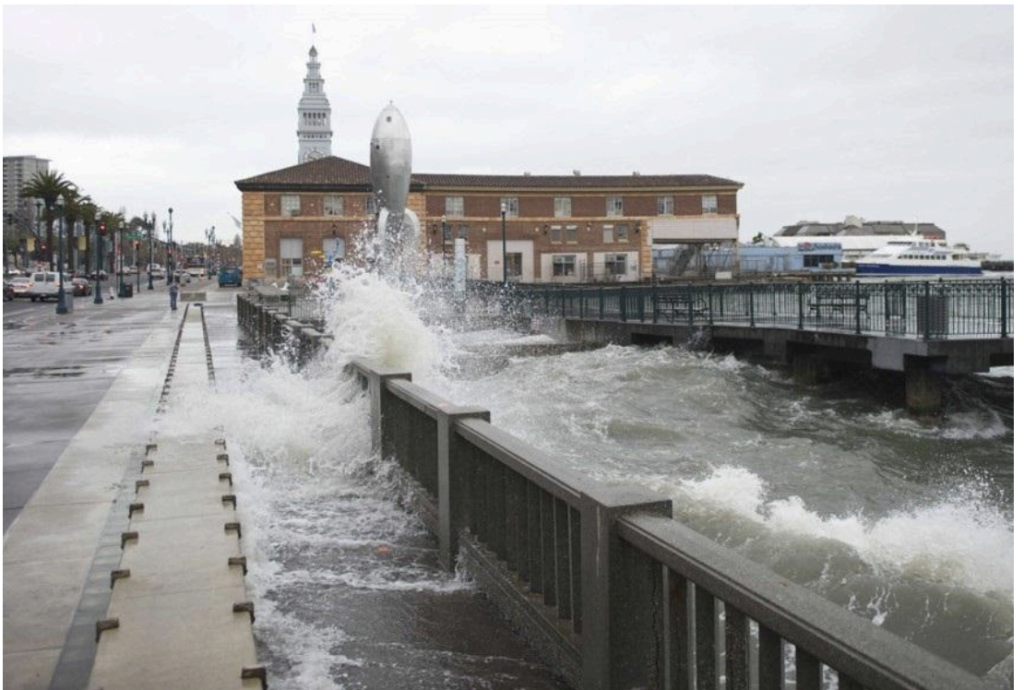>>We need you! Become a 48hills member today so we can continue our incredible local news + culture coverage. Just $20 a month helps sustain us. Join us here.
San Francisco’s not set to fare well with rising tides, a Tuesday report from the SF Civil Grand Jury found.
A group of 19 jurors, city residents who were appointed by a Superior Court Judge last July, authored the 65-page “Come Hell or High Water: Flood Management in a Changing Climate” report. Following 10 months of research and analysis, the report details flaws within the city’s flood management response, specifically that of Mayor London Breed’s Climate Resilience Program, ClimateSF.
“The big issues are money and transparency,” Ralph Lane, the main author of the report, told me.

The jury’s six major findings are as follows:
ClimateSF assists in coordinating planning projects, yet lacks the authority to coordinate project implementation and management.
The charter of ClimateSF states that the program implements “coordinated planning and performance management” of climate infrastructure projects, but is not authorized with their implementation or project management, the report states.
Flood management lacks the necessary interdepartmental coordination.
The jurors found “no specific process in place to optimize… collaboration [between departments]” in the report. They exemplified this issue with both the Ocean Beach Climate Change Adaptation Project and the Army Corps of Engineers Coastal Flood Study for their intentions of better flood management, but pitfalls such as delays and financial burden, which, the jurors argued, could have been avoided if there had been more interdepartmental coordination.
With no plan to fund the necessary adaptation infrastructure, the city is hampered by a self-imposed limit on the use of debt finance.
The jury found that the city plans to finance climate resilience projects and infrastructure with “2018’s bond supplemented by bonds scheduled for voter approval in 2028 and 2032.” When combined, the bonds total less than $1 billion. The jury estimates that the city’s involvement in just the USACE Waterfront Plan will cost more than $7 billion.
So, the city needs to turn to financing using debt securities to obtain the remainder of the funds, which is also an insufficient method, the report claims. The city is only able to access a certain amount of money, and there are limitations on how that money can be utilized, according to the city’s current 10-Year Capital Plan.
The city is paying avoidable flood damage recovery costs.
Some San Francisco homeowners are mandated to purchase subsidized flood insurance with the Federal Emergency Management Agency (FEMA)’s National Flood Insurance Program (NFIP) if they are living in structures in hazard areas “that have mortgages from federally backed or federally regulated lenders,” the report says.
Insurance is not required for buildings without these mortgages. So often, these uninsured owners will obtain money from the city’s General Fund after filing claims related to the city’s lack of adequate wastewater drainage.
The city will wind up paying these avoidable damage recovery costs that may likely be “obtained by insurance underwriting,” the report suggests.
The city’s activities for climate resilience are not transparent in the city’s budget.
The report notes a lack of transparency regarding “where public money gets invested to respond to flooding.” The jury did not find any line item in the capital budget revealing how much was invested into the adaptation of “infrastructure projects devoted to climate change resilience.”
The city is failing to communicate to residents the future impacts of climate change.
ClimateSF’s charter calls for “aligned communication and engagement,” but the report argues that this is done within their own “robust public affairs organs of communication,” rather than messaging to all San Franciscans.
We reached out to Breed’s office and ClimateSF for direct comment on these claims after the report was filed, but they have yet to reply. The Mayor’s Office is required to file a formal response to the jury within 60 days of the report’s publication.
The report does acknowledge that San Francisco is one of the leaders globally on climate policy. “We’ve got a government, that I really have got to say, they’re ahead of the pack on this,” Lane said. Lane noted that he doesn’t see the report being “critical in the sense that, ‘oh, you’re doing it wrong.’ It’s more like, ‘you’ve done great so far. But in order to ramp up what’s necessary, there may need to be some fixes.’”
In the report, the jury suggested the following fixes to the city’s current flood management system:
—Reforming the process of decision making in the Climate Resilience Program
—Providing more transparency in planning for climate adaptation
—Reassessing the certain funding shortfalls needed to respond to the impacts from climate change
—Improving interdepartmental coordination by the city to address expected flooding
—Stepping up efforts to notify the public about flood insurance options and to inform the public about those areas most likely to be affected.”
“We can’t talk policy [in the report.] We can’t say what to spend your money on, but [the] process has to be in the sunshine,” Lane said. “[It] needs to be public and transparent. We’ve come back to that a couple of times in the report.”
Breed is mandated to file a response by Aug. 11. The Board of Supervisors is required to do the same by Sept. 9 (90 days after the jury’s filing) and the City Attorney’s Office 60 days after the filing. Following these responses, the issue will be scheduled for a hearing by the Board of Supervisors, in addition to the Government Audit and Oversight Committee. Once responses are filed, they can be accessed on the Civil Grand Jury’s website.
“We are surrounded by water on three sides…we have limited options.” Lane said. “For God’s sakes, if you’re going to be making these kinds of decisions, do them in a fishbowl.”




